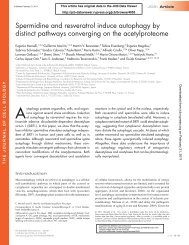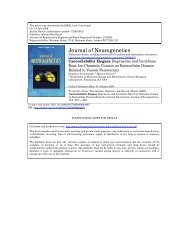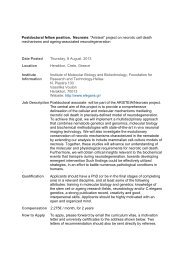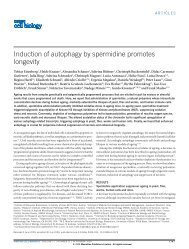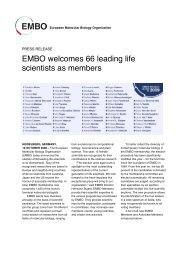CELL BIOLOGY OF THE NEURON Polarity ... - Tavernarakis Lab
CELL BIOLOGY OF THE NEURON Polarity ... - Tavernarakis Lab
CELL BIOLOGY OF THE NEURON Polarity ... - Tavernarakis Lab
You also want an ePaper? Increase the reach of your titles
YUMPU automatically turns print PDFs into web optimized ePapers that Google loves.
Cell Biology of the Neuron: <strong>Polarity</strong>, Plasticity and Regeneration, Crete 2011<br />
Tubulin Polyglutamylation: a Role in Neuronal<br />
<strong>Polarity</strong> and Transport<br />
Maria Magiera, Judith Souphron, Diana Zala, Frederic Saudou, Carsten Janke<br />
Institut Curie<br />
Neurons are polarized cells and their cell body, dendrites and axon differ<br />
radically in terms of morphology, function and molecular composition. The<br />
specification of the axonal and dendritic identity occurs early in neuronal<br />
development and is maintained for decades. The mechanisms of neuron polarity<br />
establishment, maintenance and loss are not fully understood, but microtubules<br />
(MTs) seem to play an important role in these processes. Many MT-associated<br />
proteins (MAPs) and motors can be found exclusively in one of the cellular<br />
compartments, and strikingly, this distribution can be perturbed in degenerating<br />
neurons. Neuronal MTs are heavily polyglutamylated, and we have shown that<br />
deregulation of the levels of this posttranslational modification of tubulin leads to<br />
neurodegeneration. We are now interested by which mechanism tubulin<br />
polyglutamylation controls neuronal survival and we want to investigate whether<br />
it could influence the establishment and maintenance of neuronal polarity. Using<br />
primary cultures of mouse hippocampal neurons we modulate tubulin<br />
glutamylation and study the consequences of these changes on cell morphology,<br />
MAP distribution, motor traffic, axon branching, growth cone function and<br />
possible degenerative processes. First experiments have shown that tubulin is<br />
differentially modified in axons vs. dendrites and that changing tubulin<br />
glutamylation pattern in developing neurons can influence MAP localization. We<br />
are now establishing an assay allowing quantifying the impact of<br />
polyglutamylation levels on axonal transport parameters. In the next step we will<br />
investigate the role of MT polyglutamylation on MAP and motor binding and<br />
behaviour in cell-free in vitro systems.<br />
Presented by: Magiera, Maria<br />
Poster No 068<br />
Green Session<br />
150



